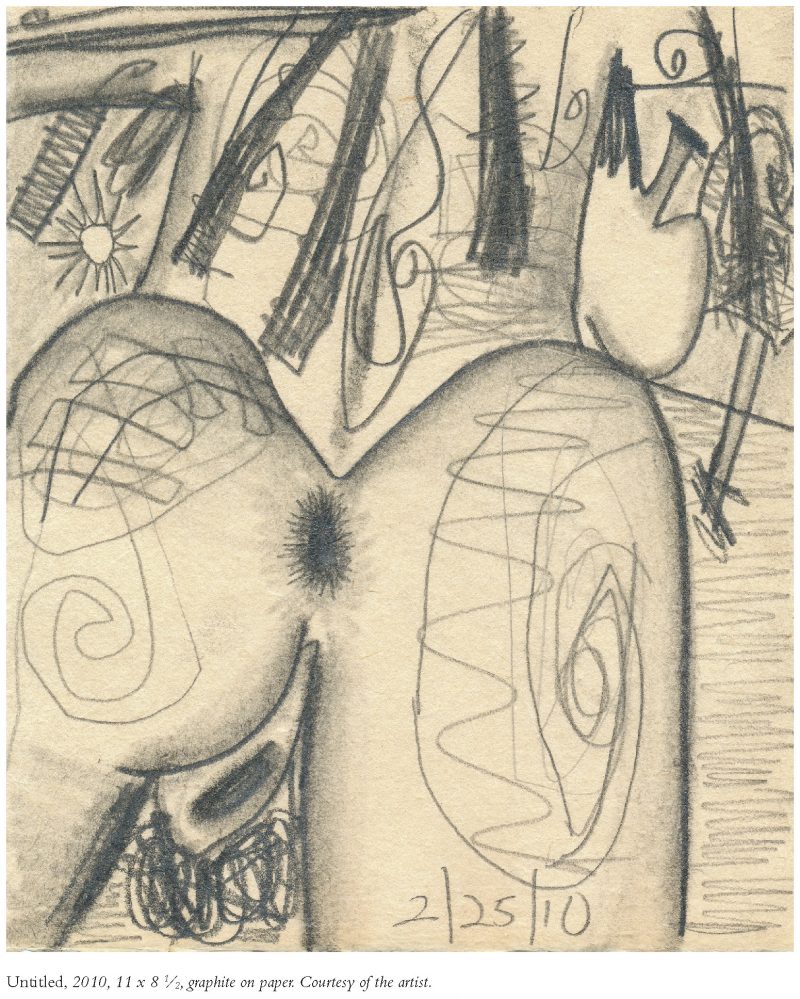Carroll Dunham has been making paintings that fuse elements of cartooning and biomorphic surrealism with various brands of abstraction since he began his New York career in the late ’70s. His imagery has evolved from simple organisms to vexed social organizations to gun-wielding men in suits and, more recently, naked women. We had this conversation at Dunham’s home in lower Manhattan in a small studio dedicated to drawing. It reveals the possibility that a hidden undercurrent of measure and formality pulses beneath his work’s surface of sexuality and violence.
—D.H.

THE BELIEVER: Do you ever work from a model?
CARROLL DUNHAM: I never work from a model. They just come out of drawing. I think that’s why I draw so much. They don’t come from anywhere else, really.
BLVR: Let’s think about the blank piece of paper; it’s a threshold you have to cross every time you make a drawing, and, in the case of this one, you’ve made an analogy between the creamy white page and ass cheeks.
CD: Blank sheets of paper always have a character. Even with quick little drawings, you’re looking for a way for the paper and the medium and the image to all braid, to all connect, as one thing.
BLVR: And with this piece you’re adding little abstract drawings onto her butt, as though they were the two halves of a magazine spread.
CD: When I was drawing this sort of image in my paintings a few years ago, it was connected to maleness. I included a tattoo that was one of the attributes of that subject.
BLVR: You’ve got the scribbled pubic hair, nested at the bottom of the picture, and the chunks of head- and armpit- hair above, lining up as if to spell a word.
CD: Well, it’s hard for me to see them that way, because I have these very simple things I imagine when I’m drawing; I know there’s a high degree of what you could call abstraction. Some time has to pass for me to see them the way you do; these are quite recent.
BLVR: It even takes me a little bit of time to recognize what’s right here on the page, such as how the arm exiting at the top left, with its little tangle of armpit-hair, frames a spiky sun, the bright morphological cousin to the dark anus.
CD: Well, the drawing construction is very similar. It’s a kind of positive-negative figure-ground reversal that completely shifts the frame of reference. I feel that I’ve only been drawing about three things over and over for years. They change their referent but they don’t really change their graphic nature.
BLVR: Your imagery seems to mythologize light and dark with body parts and celestial objects.
CD: These are all the things I’m thinking about: archetypal splits in reality that have been part of human imagining from the beginning. Likewise, the relationships between familiar body scale and cosmic scale are with me while I’m working and help me simplify my choices.
BLVR: Do you work with a limited and repeating set of elements so that you can be free from having to think about them?
CD: That’s absolutely right.
BLVR: I’m looking at that shape that seems to be sitting on her right ass cheek. It looks for a moment like a strange, pointy vessel but then switches to a negative space before becoming a stylized breast. Maybe the asshole can help us put this in perspective.
CD: Since I don’t work from observation and these things really are constructions that mix my thinking about pictures and the making of pictures, I have to figure out a way to construct them that’s meaningful to me. At the center of the construction is the asshole; I have to locate it in order to build the image. It must have some functional centrality in terms of how I think. You can take these things apart into all kinds of layers, from the really mundane/pragmatic to the psychological to the whatever, but I don’t think much beyond the needs I have to make another drawing. I’m sure you’re right; putting an image like the anus through these kinds of operations results in what you see. It becomes a star or it becomes a flower. But with so few elements, as you say, repetition can reach the point of inanity. I see it very much the way evolution apparently works. If you do the same thing over and over again, there will be a shift.




